Abstract
We have characterized the determinants of methotrexate (MTX) responsiveness in eight patient-derived cell lines of small-cell lung cancer (SCLC). Clonogenic survival was correlated with factors known to affect sensitivity to drug. NCI-H209 and NCI-H128 were most drug sensitive, with drug concentrations required to inhibit clonogenic survival by 50% with less than 0.1 microM MTX. Six cell lines (NCI-H187, NCI-H345, NCI-H60, NCI-H524, NCI-H146, and NCI-N417D) were relatively drug resistant. In all cell lines studied, higher molecular weight MTX-polyglutamates (MTX-PGs) with 3-5 glutamyl moieties (MTX-Glu3 through MTX-Glu5) were selectively retained. Relative resistance to low (1.0 microM) drug concentrations appeared to be largely due to decreased intracellular metabolism of MTX. Five of the six resistant lines were able to synthesize polyglutamates at higher (10 microM) drug concentrations, although one resistant cell line (NCI-N417D) did not synthesize higher molecular weight MTX-PGs, even after exposure to 10 microM drug. Two cell lines with resistance to 10 microM MTX (NCI-H146 and NCI-H524) synthesized and retained higher molecular weight MTX-PGs in excess of binding capacity after exposure to 10 microM drug. However, the specific activity of thymidylate synthase in these cell lines was low. MTX sensitivity in patient-derived cell lines of SCLC requires the ability of cells to accumulate and retain intracellular drug in the form of polyglutamate metabolites in excess of dihydrofolate reductase, as well as a high basal level of consumption of reduced folates in the synthesis of thymidylate.
Full text
PDF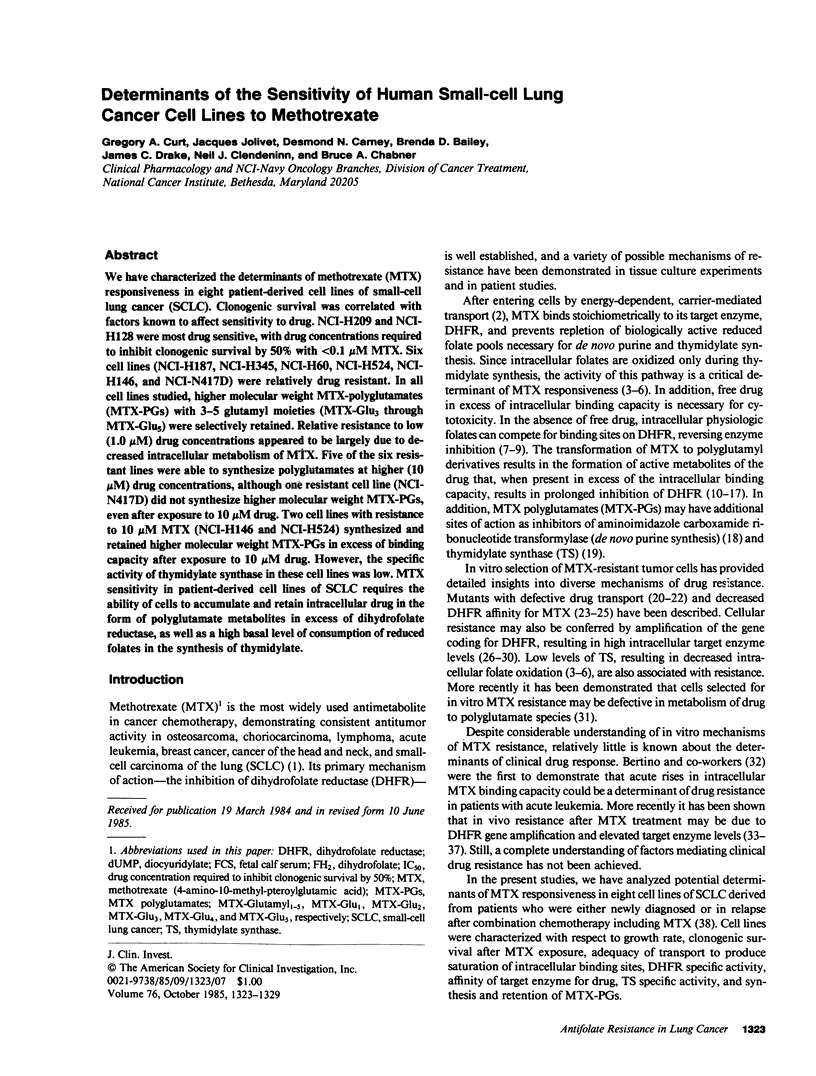

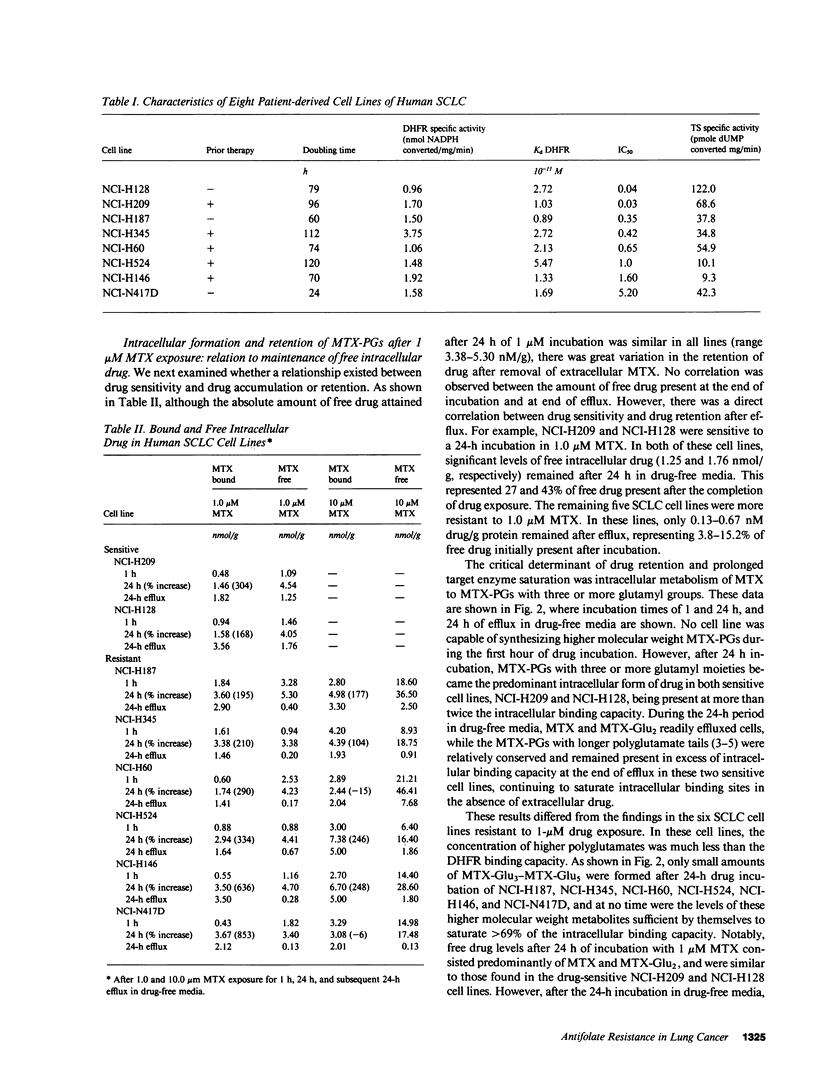
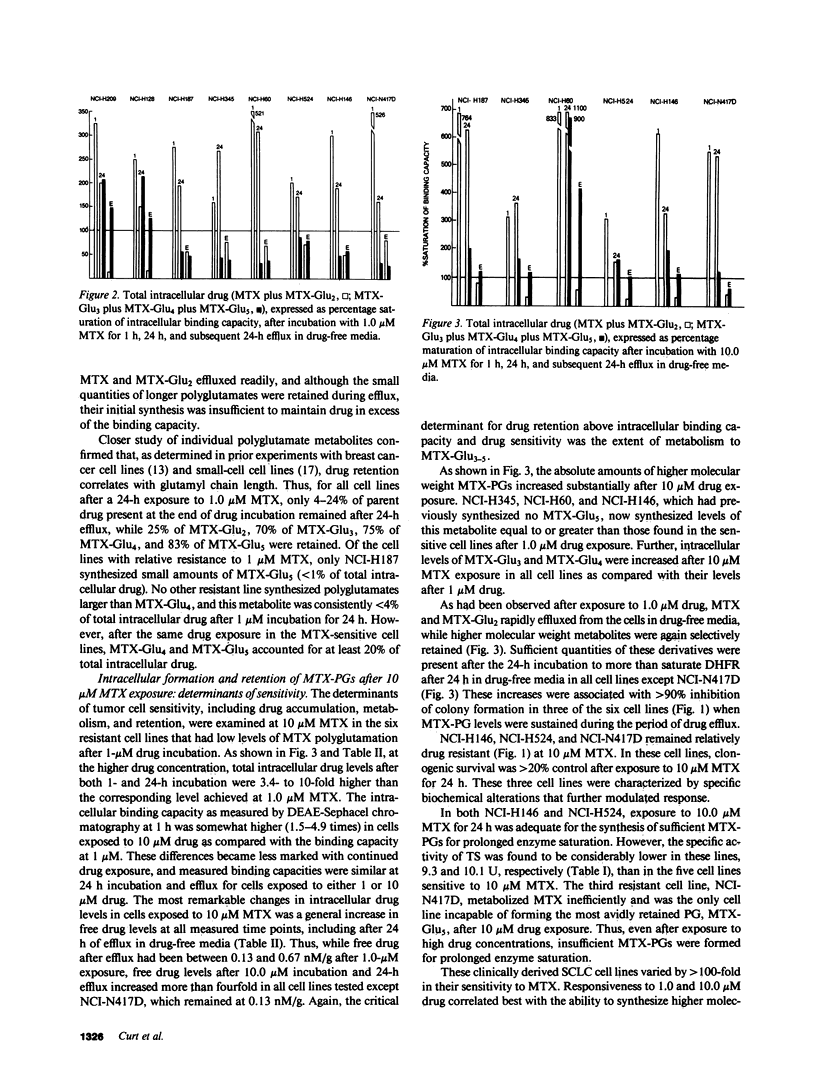
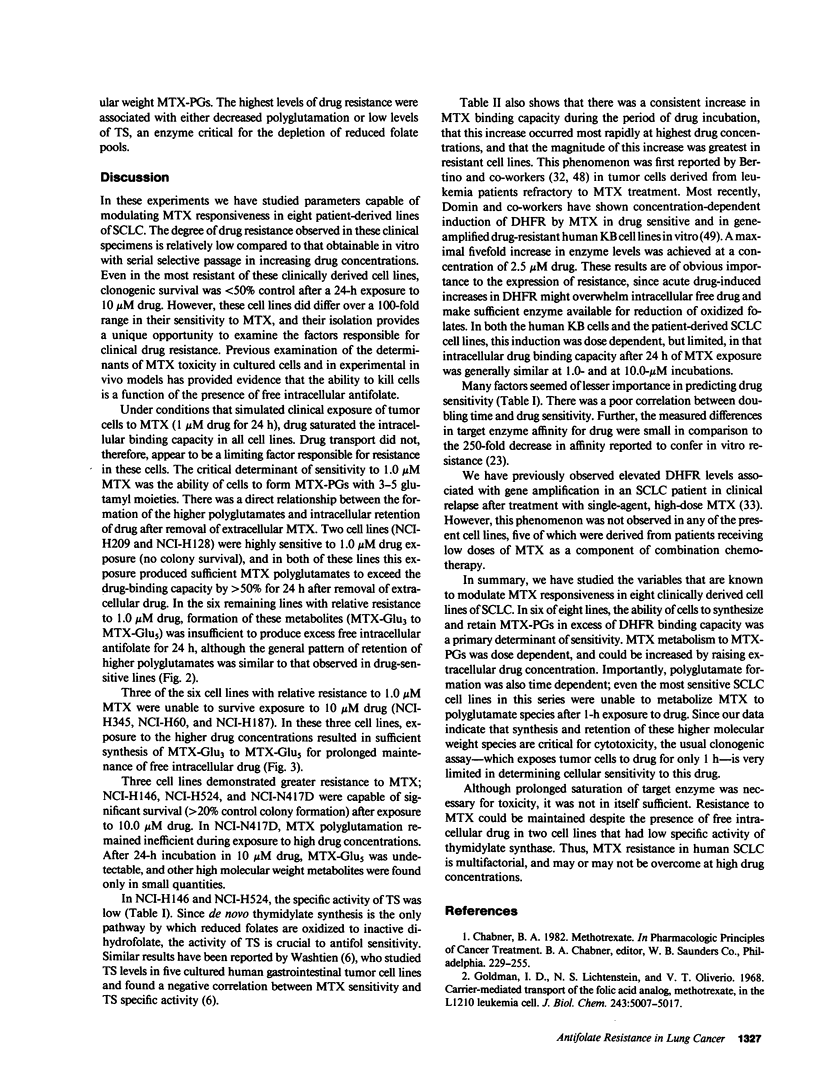
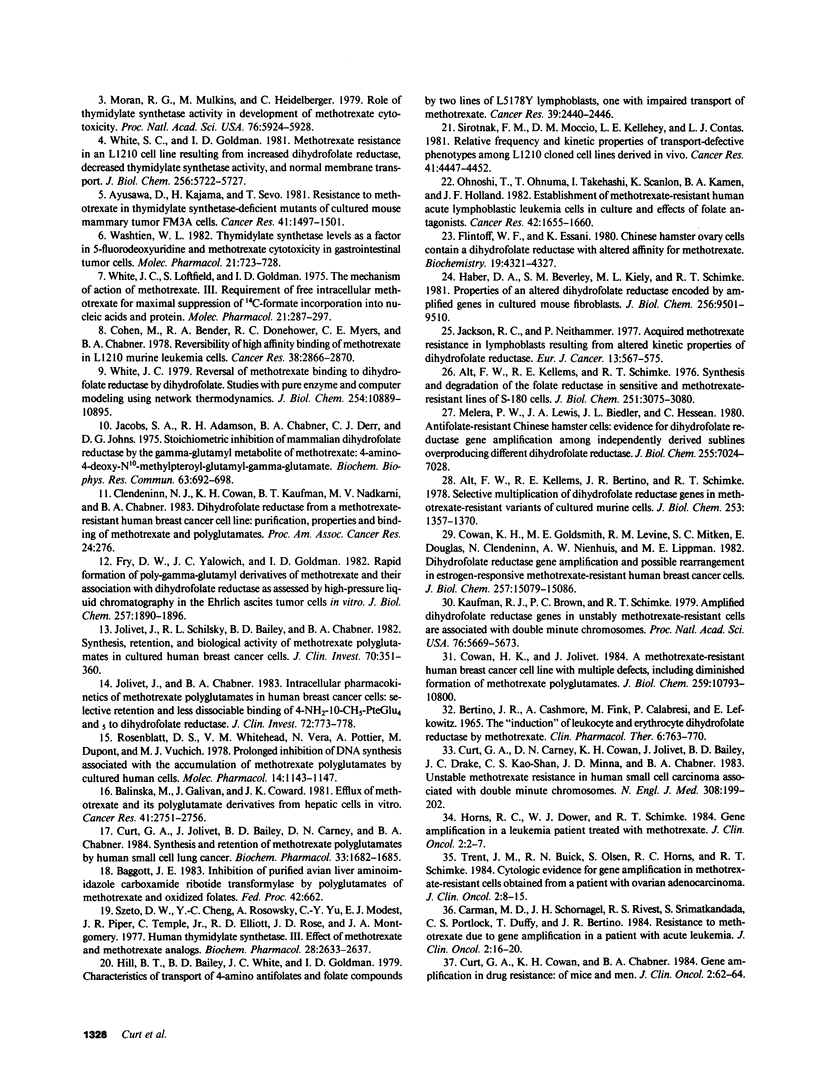
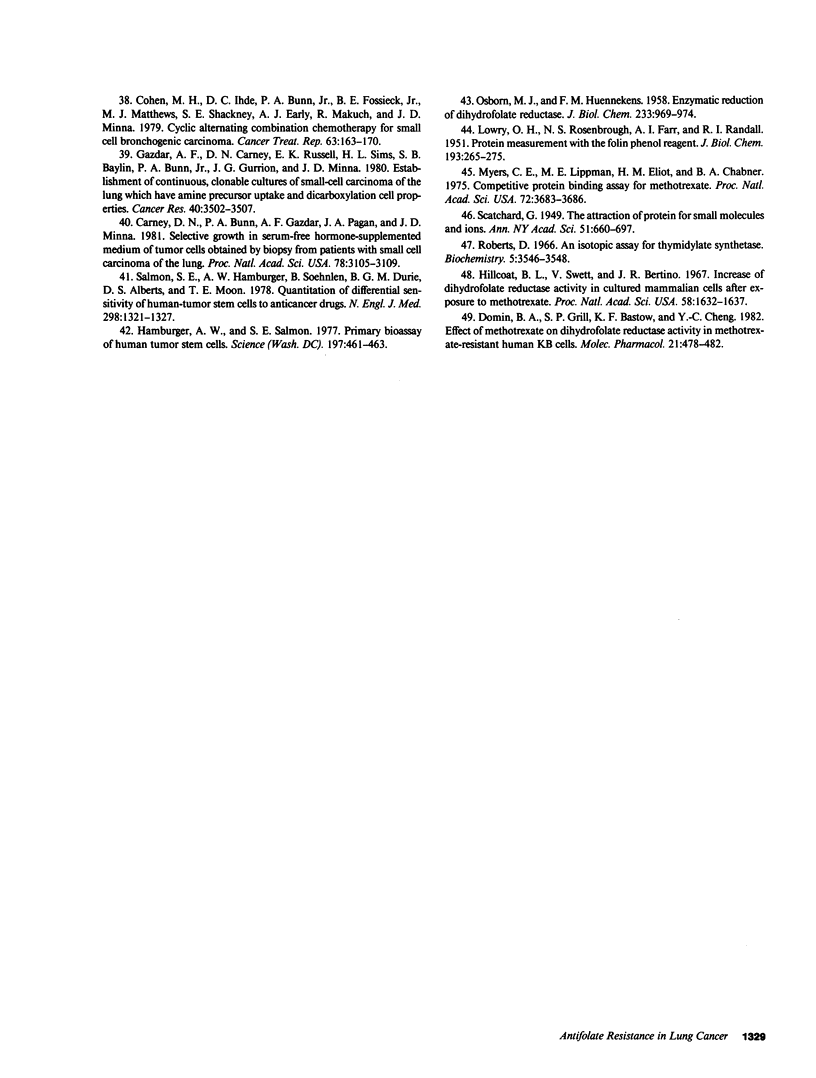
Selected References
These references are in PubMed. This may not be the complete list of references from this article.
- Alt F. W., Kellems R. E., Bertino J. R., Schimke R. T. Selective multiplication of dihydrofolate reductase genes in methotrexate-resistant variants of cultured murine cells. J Biol Chem. 1978 Mar 10;253(5):1357–1370. [PubMed] [Google Scholar]
- Ayusawa D., Koyama H., Seno T. Resistance to methotrexate in thymidylate synthetase-deficient mutants of cultured mouse mammary tumor FM3A cells. Cancer Res. 1981 Apr;41(4):1497–1501. [PubMed] [Google Scholar]
- Balińska M., Galivan J., Coward J. K. Efflux of methotrexate and its polyglutamate derivatives from hepatic cells in vitro. Cancer Res. 1981 Jul;41(7):2751–2756. [PubMed] [Google Scholar]
- Bertino J. R., Cashmore A., Fink M., Calabresi P., Lefkowitz E. The "induction" of leukocyte and erythrocyte dihydrofolate reductase by methotrexate. II. Clinical and pharmacologic studies. Clin Pharmacol Ther. 1965 Nov-Dec;6(6):763–770. doi: 10.1002/cpt196566763. [DOI] [PubMed] [Google Scholar]
- Carman M. D., Schornagel J. H., Rivest R. S., Srimatkandada S., Portlock C. S., Duffy T., Bertino J. R. Resistance to methotrexate due to gene amplification in a patient with acute leukemia. J Clin Oncol. 1984 Jan;2(1):16–20. doi: 10.1200/JCO.1984.2.1.16. [DOI] [PubMed] [Google Scholar]
- Cohen M. H., Ihde D. C., Bunn P. A., Jr, Fossieck B. E., Jr, Matthews M. J., Shackney S. E., Johnston-Early A., Makuch R., Minna J. D. Cyclic alternating combination chemotherapy for small cell bronchogenic carcinoma. Cancer Treat Rep. 1979 Feb;63(2):163–170. [PubMed] [Google Scholar]
- Cohen M., Bender R. A., Donehower R., Myers C. E., Chabner B. A. Reversibility of high-affinity binding of methotrexate in L1210 murine leukemia cells. Cancer Res. 1978 Sep;38(9):2866–2870. [PubMed] [Google Scholar]
- Cowan K. H., Goldsmith M. E., Levine R. M., Aitken S. C., Douglass E., Clendeninn N., Nienhuis A. W., Lippman M. E. Dihydrofolate reductase gene amplification and possible rearrangement in estrogen-responsive methotrexate-resistant human breast cancer cells. J Biol Chem. 1982 Dec 25;257(24):15079–15086. [PubMed] [Google Scholar]
- Cowan K. H., Jolivet J. A methotrexate-resistant human breast cancer cell line with multiple defects, including diminished formation of methotrexate polyglutamates. J Biol Chem. 1984 Sep 10;259(17):10793–10800. [PubMed] [Google Scholar]
- Curt G. A., Carney D. N., Cowan K. H., Jolivet J., Bailey B. D., Drake J. C., Chien Song K. S., Minna J. D., Chabner B. A. Unstable methotrexate resistance in human small-cell carcinoma associated with double minute chromosomes. N Engl J Med. 1983 Jan 27;308(4):199–202. doi: 10.1056/NEJM198301273080406. [DOI] [PubMed] [Google Scholar]
- Curt G. A., Cowan K. H., Chabner B. A. Gene amplification in drug resistance: of mice and men. J Clin Oncol. 1984 Jan;2(1):62–64. doi: 10.1200/JCO.1984.2.1.62. [DOI] [PubMed] [Google Scholar]
- Curt G. A., Jolivet J., Bailey B. D., Carney D. N., Chabner B. A. Synthesis and retention of methotrexate polyglutamates by human small cell lung cancer. Biochem Pharmacol. 1984 May 15;33(10):1682–1685. doi: 10.1016/0006-2952(84)90292-2. [DOI] [PubMed] [Google Scholar]
- Domin B. A., Grill S. P., Bastow K. F., Cheng Y. C. Effect of methotrexate on dihydrofolate reductase activity in methotrexate-resistant human KB cells. Mol Pharmacol. 1982 Mar;21(2):478–482. [PubMed] [Google Scholar]
- Flintoff W. F., Essani K. Methotrexate-resistant Chinese hamster ovary cells contain a dihydrofolate reductase with an altered affinity for methotrexate. Biochemistry. 1980 Sep 2;19(18):4321–4327. doi: 10.1021/bi00559a027. [DOI] [PubMed] [Google Scholar]
- Fry D. W., Yalowich J. C., Goldman I. D. Rapid formation of poly-gamma-glutamyl derivatives of methotrexate and their association with dihydrofolate reductase as assessed by high pressure liquid chromatography in the Ehrlich ascites tumor cell in vitro. J Biol Chem. 1982 Feb 25;257(4):1890–1896. [PubMed] [Google Scholar]
- Gazdar A. F., Carney D. N., Russell E. K., Sims H. L., Baylin S. B., Bunn P. A., Jr, Guccion J. G., Minna J. D. Establishment of continuous, clonable cultures of small-cell carcinoma of lung which have amine precursor uptake and decarboxylation cell properties. Cancer Res. 1980 Oct;40(10):3502–3507. [PubMed] [Google Scholar]
- Goldman I. D., Lichtenstein N. S., Oliverio V. T. Carrier-mediated transport of the folic acid analogue, methotrexate, in the L1210 leukemia cell. J Biol Chem. 1968 Oct 10;243(19):5007–5017. [PubMed] [Google Scholar]
- Haber D. A., Beverley S. M., Kiely M. L., Schimke R. T. Properties of an altered dihydrofolate reductase encoded by amplified genes in cultured mouse fibroblasts. J Biol Chem. 1981 Sep 25;256(18):9501–9510. [PubMed] [Google Scholar]
- Hamburger A. W., Salmon S. E. Primary bioassay of human tumor stem cells. Science. 1977 Jul 29;197(4302):461–463. doi: 10.1126/science.560061. [DOI] [PubMed] [Google Scholar]
- Hill B. T., Bailey B. D., White J. C., Goldman I. D. Characteristics of transport of 4-amino antifolates and folate compounds by two lines of L5178Y lymphoblasts, one with impaired transport of methotrexate. Cancer Res. 1979 Jul;39(7 Pt 1):2440–2446. [PubMed] [Google Scholar]
- Hillcoat B. L., Swett V., Bertino J. R. Increase of dihydrofolate reductase activity in cultured mammalian cells after exposure to methotrexate. Proc Natl Acad Sci U S A. 1967 Oct;58(4):1632–1637. doi: 10.1073/pnas.58.4.1632. [DOI] [PMC free article] [PubMed] [Google Scholar]
- Horns R. C., Jr, Dower W. J., Schimke R. T. Gene amplification in a leukemic patient treated with methotrexate. J Clin Oncol. 1984 Jan;2(1):2–7. doi: 10.1200/JCO.1984.2.1.2. [DOI] [PubMed] [Google Scholar]
- Jackson R. C., Niethammer D. Acquired methotrexate resistance in lymphoblasts resulting from altered kinetic properties of dihydrofoltate reductase. Eur J Cancer. 1977 Jun;13(6):567–575. doi: 10.1016/0014-2964(77)90118-9. [DOI] [PubMed] [Google Scholar]
- Jacobs S. A., Adamson R. H., Chabner B. A., Derr C. J., Johns D. C. Stoichiometric inhibition of mammalian dihydrofolate reductase by the gamma-glutamyl metabolite of methotrexiate, 4-amino-4-deoxy-N-10-methylpteroylglutamyl-gamma-glutamate. Biochem Biophys Res Commun. 1975 Apr 7;63(3):692–698. doi: 10.1016/s0006-291x(75)80439-6. [DOI] [PubMed] [Google Scholar]
- Jolivet J., Chabner B. A. Intracellular pharmacokinetics of methotrexate polyglutamates in human breast cancer cells. Selective retention and less dissociable binding of 4-NH2-10-CH3-pteroylglutamate4 and 4-NH2-10-CH3-pteroylglutamate5 to dihydrofolate reductase. J Clin Invest. 1983 Sep;72(3):773–778. doi: 10.1172/JCI111048. [DOI] [PMC free article] [PubMed] [Google Scholar]
- Jolivet J., Schilsky R. L., Bailey B. D., Drake J. C., Chabner B. A. Synthesis, retention, and biological activity of methotrexate polyglutamates in cultured human breast cancer cells. J Clin Invest. 1982 Aug;70(2):351–360. doi: 10.1172/JCI110624. [DOI] [PMC free article] [PubMed] [Google Scholar]
- Kaufman R. J., Brown P. C., Schimke R. T. Amplified dihydrofolate reductase genes in unstably methotrexate-resistant cells are associated with double minute chromosomes. Proc Natl Acad Sci U S A. 1979 Nov;76(11):5669–5673. doi: 10.1073/pnas.76.11.5669. [DOI] [PMC free article] [PubMed] [Google Scholar]
- LOWRY O. H., ROSEBROUGH N. J., FARR A. L., RANDALL R. J. Protein measurement with the Folin phenol reagent. J Biol Chem. 1951 Nov;193(1):265–275. [PubMed] [Google Scholar]
- Melera P. W., Lewis J. A., Biedler J. L., Hession C. Antifolate-resistant Chinese hamster cells. Evidence for dihydrofolate reductase gene amplification among independently derived sublines overproducing different dihydrofolate reductases. J Biol Chem. 1980 Jul 25;255(14):7024–7028. [PubMed] [Google Scholar]
- Moran R. G., Mulkins M., Heidelberger C. Role of thymidylate synthetase activity in development of methotrexate cytotoxicity. Proc Natl Acad Sci U S A. 1979 Nov;76(11):5924–5928. doi: 10.1073/pnas.76.11.5924. [DOI] [PMC free article] [PubMed] [Google Scholar]
- Myers C. E., Lippman M. E., Elliot H. M., Chabner B. A. Competitive protein binding assay for methotrexate. Proc Natl Acad Sci U S A. 1975 Sep;72(9):3683–3686. doi: 10.1073/pnas.72.9.3683. [DOI] [PMC free article] [PubMed] [Google Scholar]
- OSBORN M. J., HUENNEKENS F. M. Enzymatic reduction of dihydrofolic acid. J Biol Chem. 1958 Oct;233(4):969–974. [PubMed] [Google Scholar]
- Ohnoshi T., Ohnuma T., Takahashi I., Scanlon K., Kamen B. A., Holland J. F. Establishment of methotrexate-resistant human acute lymphoblastic leukemia cells in culture and effects of folate antagonists. Cancer Res. 1982 May;42(5):1655–1660. [PubMed] [Google Scholar]
- Roberts D. An isotopic assay for thymidylate synthetase. Biochemistry. 1966 Nov;5(11):3546–3548. doi: 10.1021/bi00875a022. [DOI] [PubMed] [Google Scholar]
- Rosenblatt D. S., Whitehead V. M., Vera N., Pottier A., Dupont M., Vuchich M. J. Prolonged inhibition of DNA synthesis associated with the accumulation of methotrexate polyglutamates by cultured human cells. Mol Pharmacol. 1978 Nov;14(6):1143–1147. [PubMed] [Google Scholar]
- Salmon S. E., Hamburger A. W., Soehnlen B., Durie B. G., Alberts D. S., Moon T. E. Quantitation of differential sensitivity of human-tumor stem cells to anticancer drugs. N Engl J Med. 1978 Jun 15;298(24):1321–1327. doi: 10.1056/NEJM197806152982401. [DOI] [PubMed] [Google Scholar]
- Sirotnak F. M., Moccio D. M., Kelleher L. E., Goutas L. J. Relative frequency and kinetic properties of transport-defective phenotypes among methotrexate-resistant L1210 clonal cell lines derived in vivo. Cancer Res. 1981 Nov;41(11 Pt 1):4447–4452. [PubMed] [Google Scholar]
- Szeto D. W., Cheng Y. C., Rosowsky A., Yu C. S., Modest E. J., Piper J. R., Temple C., Jr, Elliott R. D., Rose J. D., Montgomery J. A. Human thymidylate synthetase--III. Effects of methotrexate and folate analogs. Biochem Pharmacol. 1979 Sep 1;28(17):2633–2637. doi: 10.1016/0006-2952(79)90039-x. [DOI] [PubMed] [Google Scholar]
- Trent J. M., Buick R. N., Olson S., Horns R. C., Jr, Schimke R. T. Cytologic evidence for gene amplification in methotrexate-resistant cells obtained from a patient with ovarian adenocarcinoma. J Clin Oncol. 1984 Jan;2(1):8–15. doi: 10.1200/JCO.1984.2.1.8. [DOI] [PubMed] [Google Scholar]
- Washtien W. L. Thymidylate synthetase levels as a factor in 5-fluorodeoxyuridine and methotrexate cytotoxicity in gastrointestinal tumor cells. Mol Pharmacol. 1982 May;21(3):723–728. [PubMed] [Google Scholar]
- White J. C., Goldman I. D. Methotrexate resistance in al L1210 cell line resulting from increased dihydrofolate reductase, decreased thymidylate synthetase activity, and normal membrane transport. Computer simulations based on network thermodynamics. J Biol Chem. 1981 Jun 10;256(11):5722–5727. [PubMed] [Google Scholar]
- White J. C., Loftfield S., Goldman I. D. The mechanism of action of methotrexate. III. Requirement of free intracellular methotrexate for maximal suppression of (14C)formate incorporation into nucleic acids and protein. Mol Pharmacol. 1975 May;11(3):287–297. [PubMed] [Google Scholar]
- White J. C. Reversal of methotrexate binding to dihydrofolate reductase by dihydrofolate. Studies with pure enzyme and computer modeling using network thermodynamics. J Biol Chem. 1979 Nov 10;254(21):10889–10895. [PubMed] [Google Scholar]


